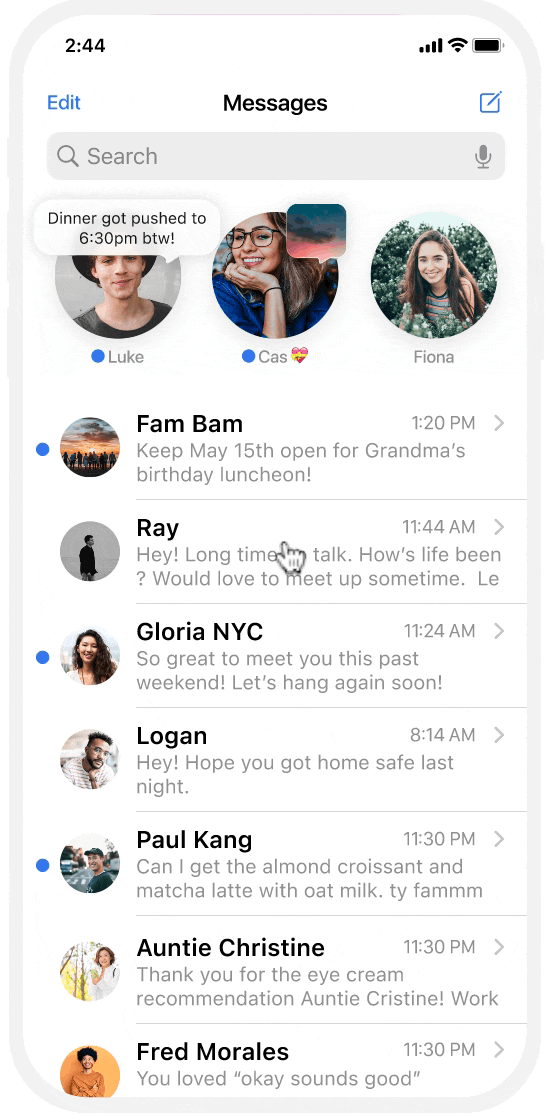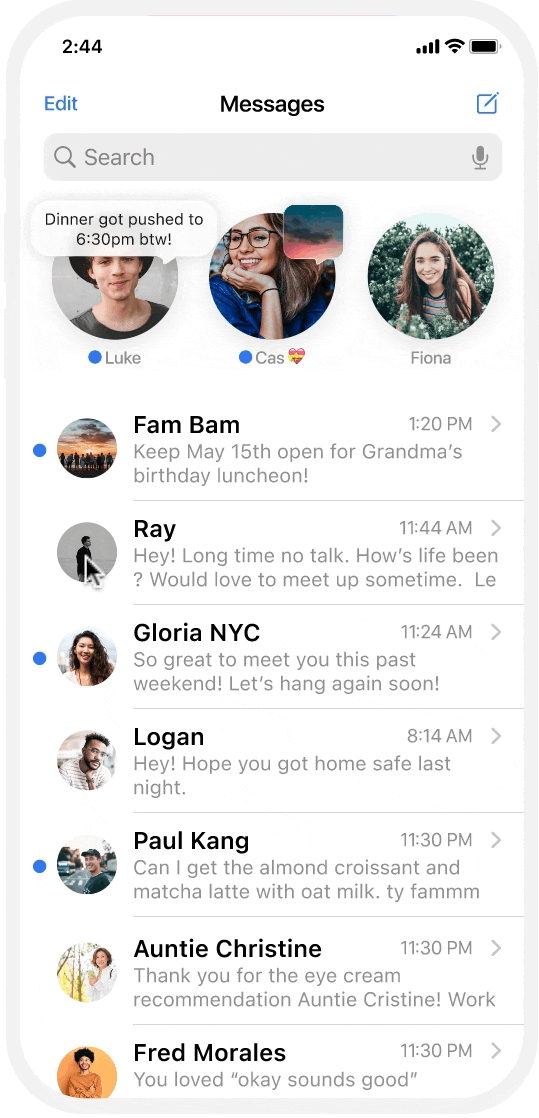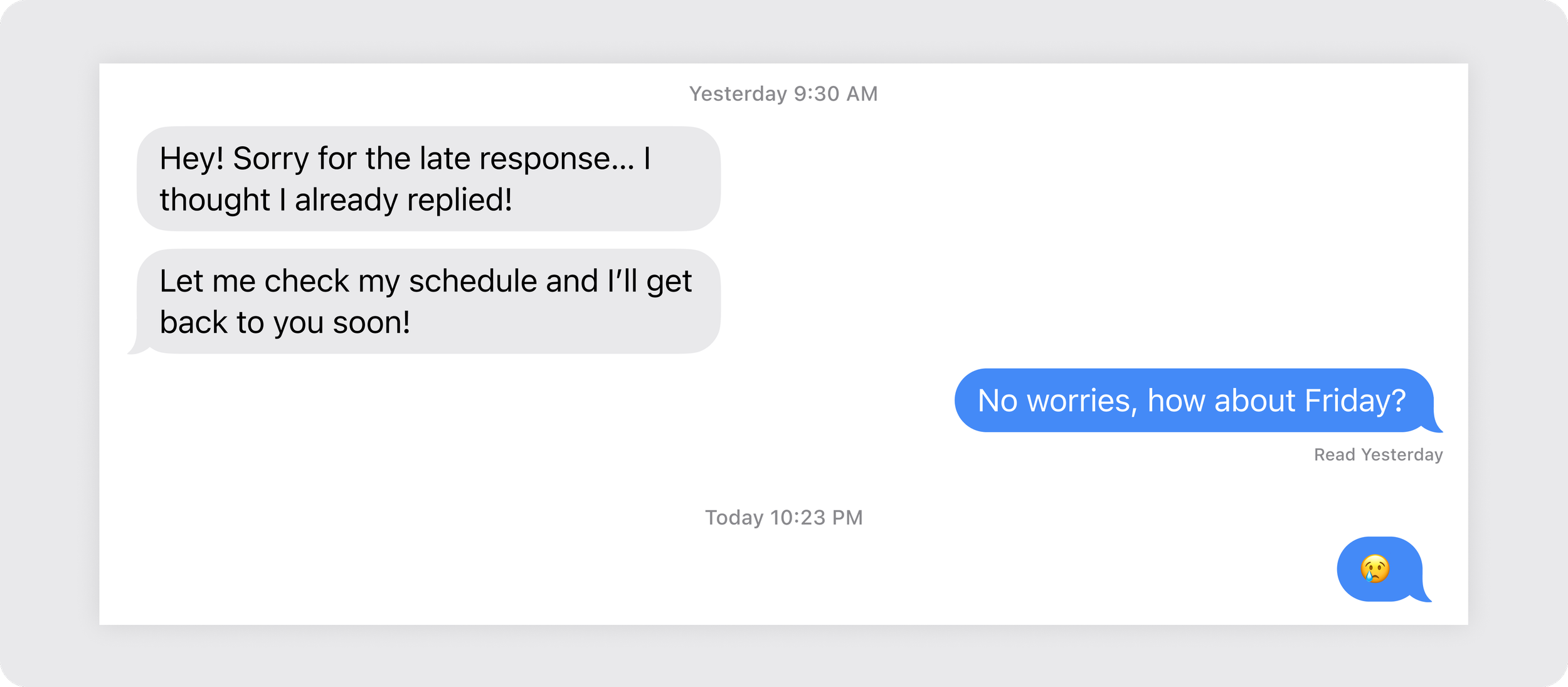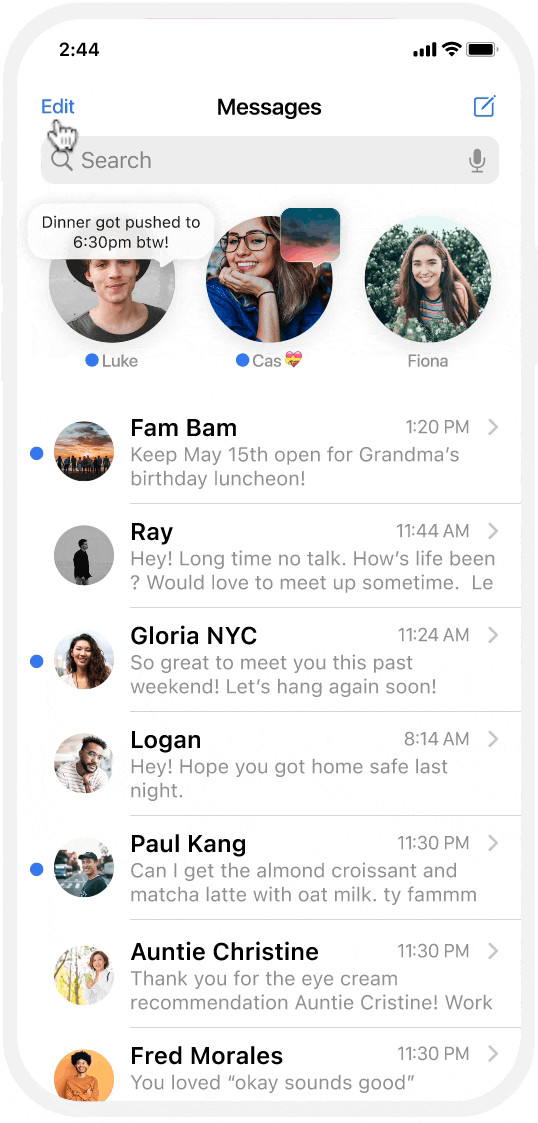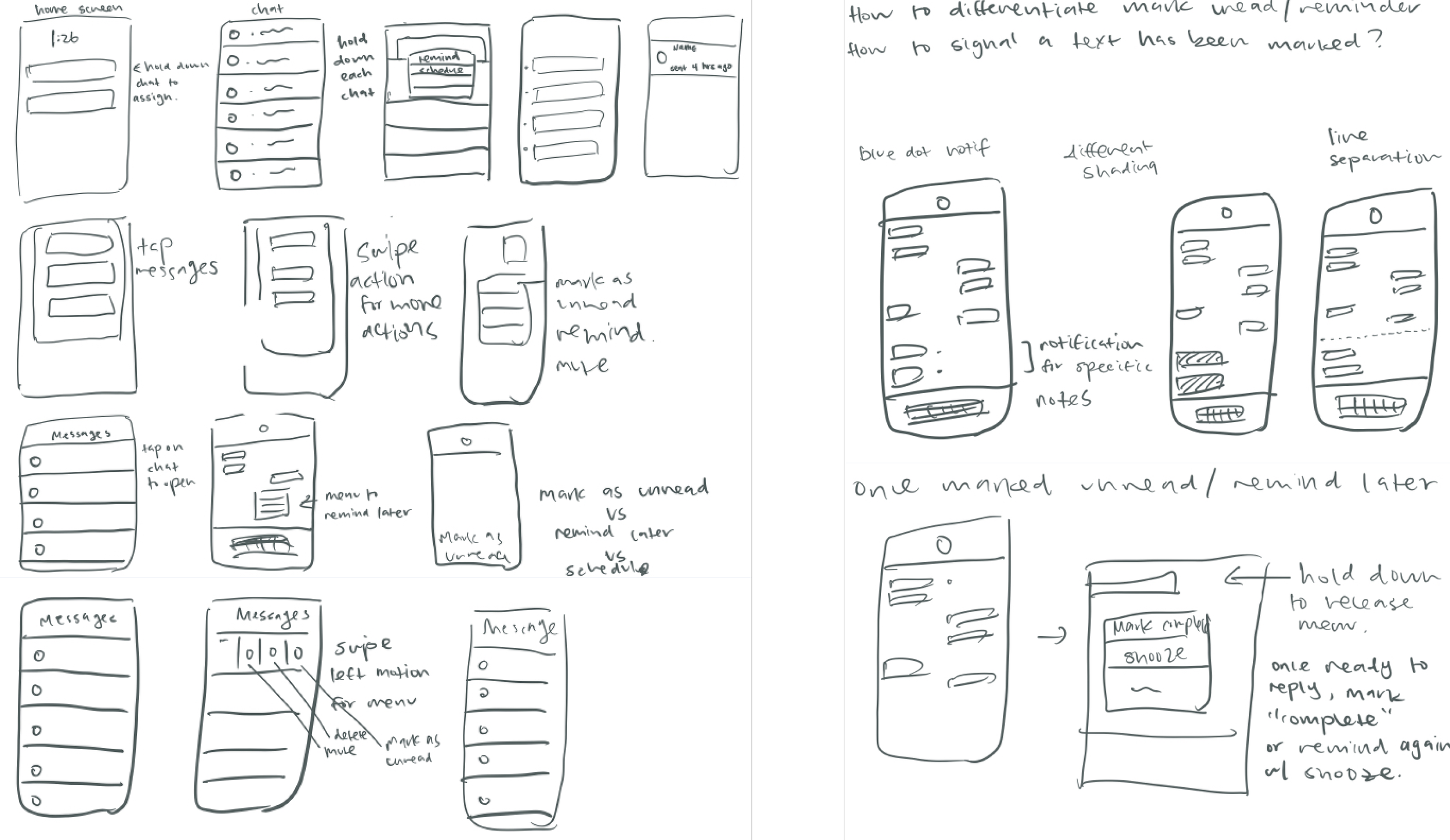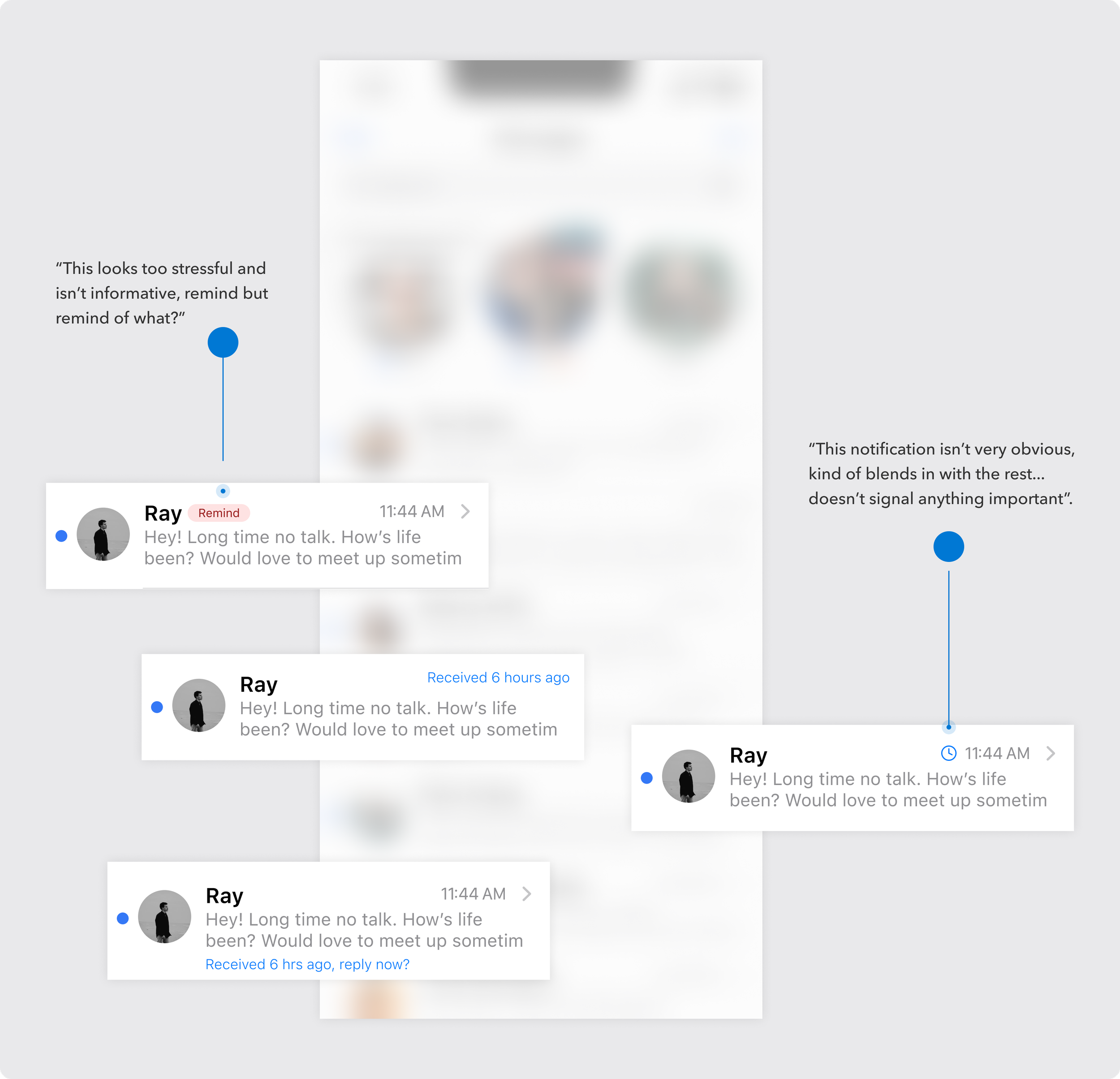Mark Unread in iMessage
Restore your notification for opened but unreplied text messages in iMessage.
Role
Product viability & direction, research, ideations, mobile design, interaction design, wireframes, user flows, usability testing, UI, design system creation and management, prototype and testing
Tools
Figma, Invision
Timeline
6 weeks
Before iOS 16
Overview
As a long-time iPhone user and notoriously “bad texter,” I considered why I would often forget to reply to texts until several days later when a follow-up message comes through, or I suddenly remember our chat in a panic. As I talked to fellow “bad texters,” I realized we all wanted to address this pain point as it would cause frustration with ourselves and others.
With this pain point in mind, I sought to discover whether a mark unread feature would aid users in responding to forgotten texts faster.

Problem
Misunderstandings and miscommunication can arise when people open but forget to respond after looking at a text message.
Solution
How might we create an experience that intuitively integrates a feature to iMessage for users to revisit opened yet unresponded text messages in an unobtrusive and timely manner?
Swipe Left
Long Press
Multi- Select
In- Message
Competitive Analysis
A highly saturated market of competitive mobile messaging apps possess dynamic and nuanced communication features that allows users to delete/recall, mark as unread, and remind.
The utility of these features is clearly well-appreciated among users as they were referenced several times throughout my user interviews when I sought to learn how users hope to remember their unresponded texts.
📌
Pinning opened text messages to the top
User Interviews
5 lead user interviews uncovered that users are already using existing iPhone features to compensate for this need.
📬
Actively not open text messages
🛎
Notification center to track unopened text messages
📝
Reminder app to remind self about text messages
Research Objectives
User interviews were conducted with three main objectives to understand motivations and pain points.
Ultimately, I learned
Users desire an easy and intuitive feature to remind themselves of unresponded text messages for clear and timely communication.
Research Findings
Generative user research conducted with 5 participants unveiled that users desire a simple and seamless feature that surfaces unresponded but opened texts.
Discovery
A simple Google search results page will populate multiple opinion pieces expressing the qualms of users who desire such a feature. User interviews further validated this assumption.
The dreaded bias
In a brainstorm with my mentor, I realized that I may have pushed a biased solution.
Given that this was my first self-led project, I got lost and approached my interviews with potentially leading questions that skewed toward particular solutions inspired by existing email features such as “mark unread” and “remind later”.
Despite the devastation (dramatic, I know), I was advised to revisit my interviews and affinity maps in hopes of drawing out other patterns of user needs. I deliberated whether one or both features would be kept.
Personas
How might the way users prefer to interact with notifications directly influence how they receive and process incoming texts?
Therefore…
Would two different features: Mark Unread and a Remind Later iMessage feature address the unique need of both personas respectively?
Mark Unread for the Notification-averse Novice
Would restoring the blue dot notification be effective enough for Eden to remember to respond to missed text messages?
Remind Later
Would a remind later notification trigger enough alert for Kennedy to differentiate among her sea of notifications?
User Flow
Despite the hiccup, I decided to continue with these two solutions in the user flow to validate during user testing after the new revelation from the personas.
Based on the assumption of the personas and their motivations, a user flow with two options was created for users after deciding not to reply: mark unread or remind later. (click to expand)
Sketches
Swipes, long presses and menus are utilized to create simple and fluid actions.
Before sketching, I explored how different haptics behaved in iMessage to optimize for users who open a text but don’t have time to respond.
High-Fi Prototype and Testing
The main objective was to observe how users intuitively expect to cue texts they haven’t responded to yet.
Since iOS already had an existing design system, I was able to leverage those components to make a hi-fi prototype. Usability testing was conducted in person on a mobile device with the Invision prototype, with 5 participants testing different haptics for messages to “mark unread” and/ or “remind later” from various access points.
Key Findings
Mark Unread performed as expected, with 100% of participants successfully marking a message as unread. The Remind Later notification will need a redesign and more exploration of how it behaves.
While I expected the Remind Later feature to be more of an edge case, I was surprised by how the user feedback was consistent with my assumption that the Remind Later feature would still be utilized depending on user preference with notifications.
General Insights
validated the assumption that how users interact with notifications affects which feature users prefer
users would use Mark Unread but like the Remind Later option as well
Mark Unread
users think that restoring the blue dot is sufficient enough to remember unanswered texts
100% of users were able to mark messages as unread
swipe left haptic was most intuitive
Remind Later
Remind later feature is reserved for “important” messages that require timely attention
users are willing to put more effort into remind later to ensure they respond
Remind later needs to look obvious and distinct
Iterations
Remind Later Feature
A challenge in considering how users would be reminded of a text was to design a solution that looked like it belonged to iOS. It had to effectively register as something different than a typical text coming in but provide enough information to indicate to users that they had previously set this reminder and maintain the integrity of time. Several iterations were explored before landing on this solution.
Timer Customization
Users felt limited with the time options after assigning texts as Remind Later as they may not be available at such set times.
Users classify Remind Later texts as more important or time-sensitive therefore they would be more willing to invest more thought and customization to ensure they are available to respond at the appointed reminder time.
Post- Usability Test Iterations
Final
Post- Usability Test Iterations
Final
Polish
The final product allows the users several entry points to mark a message as unread as well as add assign a message as Remind Later.
Swipe Left
Long Press
Multi- Select
In- Message
Remind Later
What I learned
Discover the problem.
Seems like a no-brainer, right? Then came the dreaded “bias” pointed out by my mentor. With the prompt being “added feature to existing product”. I realized I had decided on the solution before researching and validating my assumption of the problem. Unfortunately, I had already conducted my user interviews before realizing that I might have possessed a biased view in approaching my interviews and asked follow-up questions that skewed toward these particular solutions.
Next Steps
I want to continue to iterate upon my reminder solution. I feel like the UI could be improved to be more seamless and consistent with the rest of the iOS design system.

